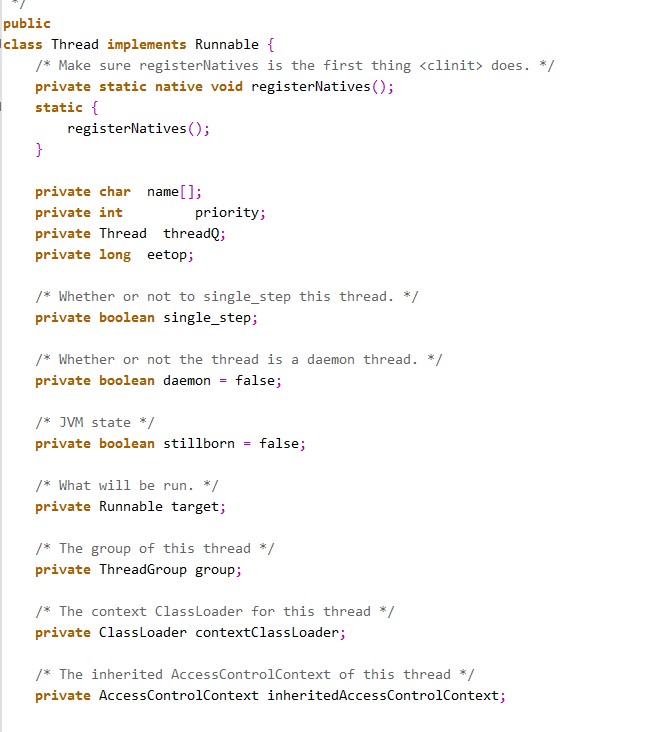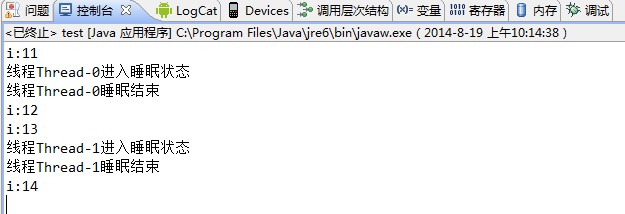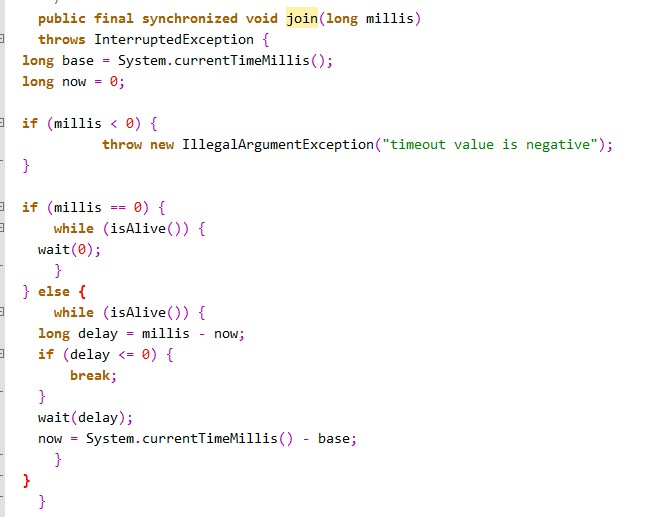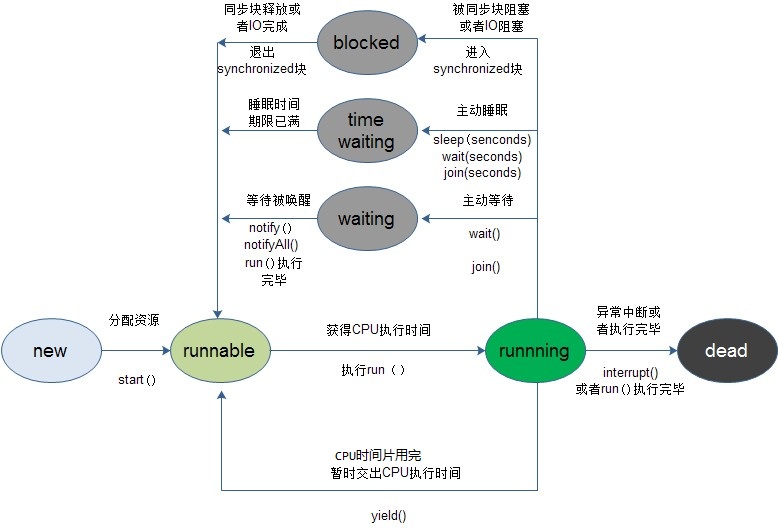大纲:
一.线程的状态
二.上下文切换
三.Thread类中的方法
转载自:
http://www.cnblogs.com/dolphin0520/p/3920357.html
一.线程的状态
线程从创建到最终的消亡,要经历若干个状态。一般来说,线程包括以下这几个状态:创建(new)、就绪(runnable)、运行(running)、阻塞(blocked)、time waiting、waiting、消亡(dead)。
线程从创建到消亡之间的状态:

二.上下文切换
对于单核CPU来说(对于多核CPU,此处就理解为一个核),CPU在一个时刻只能运行一个线程,当在运行一个线程的过程中转去运行另外一个线程,这个叫做线程上下文切换(对于进程也是类似)。
三.Thread类中的方法
通过查看java.lang.Thread类的源码可知:

Thread类实现了Runnable接口,在Thread类中,有一些比较关键的属 性,比如name是表示Thread的名字,可以通过Thread类的构造器中的参数来指定线程名字,priority表示线程的优先级(最大值为10, 最小值为1,默认值为5),daemon表示线程是否是守护线程,target表示要执行的任务。
下面是Thread类中常用的方法:
以下是关系到线程运行状态的几个方法:
1)start方法
start()用来启动一个线程,当调用start方法后,系统才会开启一个新的线程来执行用户定义的子任务,在这个过程中,会为相应的线程分配需要的资源。
2)run方法
run()方法是不需要用户来调用的,当通过start方法启动一个线程之后,当线程获得了CPU执行时间,便进入run方法体去执行具体的任务。注意,继承Thread类必须重写run方法,在run方法中定义具体要执行的任务。
3)sleep方法
sleep方法有两个重载版本:
|
1
2
3
|
sleep(long millis) //参数为毫秒
sleep(long millis,int nanoseconds) //第一参数为毫秒,第二个参数为纳秒
|
sleep相当于让线程睡眠,交出CPU,让CPU去执行其他的任务。
但是有一点要非常注意,sleep方法不会释放锁,也就是说如果当前线程持有对某个对象的锁,则即使调用sleep方法,其他线程也无法访问这个对象。看下面这个例子就清楚了:
|
1
2
3
4
5
6
7
8
9
10
11
12
13
14
15
16
17
18
19
20
21
22
23
24
25
26
27
28
29
30
31
32
33
|
public class Test {
private int i = 10;
private Object object = new Object();
public static void main(String[] args) throws IOException {
Test test = new Test();
MyThread thread1 = test.new MyThread();
MyThread thread2 = test.new MyThread();
thread1.start();
thread2.start();
}
class MyThread extends Thread{
@Override
public void run() {
synchronized (object) {
i++;
System.out.println("i:"+i);
try {
System.out.println("线程"+Thread.currentThread().getName()+"进入睡眠状态");
Thread.currentThread().sleep(10000);
} catch (InterruptedException e) {
// TODO: handle exception
}
System.out.println("线程"+Thread.currentThread().getName()+"睡眠结束");
i++;
System.out.println("i:"+i);
}
}
}
}
|
输出结果:

从上面输出结果可以看出,当Thread-0进入睡眠状态之后,Thread-1并没有去执行具体的任务。只有当Thread-0执行完之后,此时Thread-0释放了对象锁,Thread-1才开始执行。
注意,如果调用了sleep方法,必须捕获InterruptedException异常或者将该异常向上层抛出。当线程睡眠时间满后,不一定会立即得到执行,因为此时可能CPU正在执行其他的任务。所以说调用sleep方法相当于让线程进入阻塞状态。
4)yield方法
调用yield方法会让当前线程交出CPU权限,让CPU去执行其他的线程。它跟sleep方法类似,同样不会释放锁。但是yield不能控制具体的交出CPU的时间,另外,yield方法只能让拥有相同优先级的线程有获取CPU执行时间的机会。
注意,调用yield方法并不会让线程进入阻塞状态,而是让线程重回就绪状态,它只需要等待重新获取CPU执行时间,这一点是和sleep方法不一样的。
5)join方法
join方法有三个重载版本:
|
1
2
3
|
join()
join(long millis) //参数为毫秒
join(long millis,int nanoseconds) //第一参数为毫秒,第二个参数为纳秒
|
假如在main线程中,调用thread.join方法,则main方法会等待thread线程执行完毕或者等待一定的时间。如果调用的是无参join方法,则等待thread执行完毕,如果调用的是指定了时间参数的join方法,则等待一定的事件。
看下面一个例子:
|
1
2
3
4
5
6
7
8
9
10
11
12
13
14
15
16
17
18
19
20
21
22
23
24
25
26
27
28
29
30
|
public class Test {
public static void main(String[] args) throws IOException {
System.out.println("进入线程"+Thread.currentThread().getName());
Test test = new Test();
MyThread thread1 = test.new MyThread();
thread1.start();
try {
System.out.println("线程"+Thread.currentThread().getName()+"等待");
thread1.join();
System.out.println("线程"+Thread.currentThread().getName()+"继续执行");
} catch (InterruptedException e) {
// TODO Auto-generated catch block
e.printStackTrace();
}
}
class MyThread extends Thread{
@Override
public void run() {
System.out.println("进入线程"+Thread.currentThread().getName());
try {
Thread.currentThread().sleep(5000);
} catch (InterruptedException e) {
// TODO: handle exception
}
System.out.println("线程"+Thread.currentThread().getName()+"执行完毕");
}
}
}
|
输出结果:

可以看出,当调用thread1.join()方法后,main线程会进入等待,然后等待thread1执行完之后再继续执行。
实际上调用join方法是调用了Object的wait方法,这个可以通过查看源码得知:

wait方法会让线程进入阻塞状态,并且会释放线程占有的锁,并交出CPU执行权限。
由于wait方法会让线程释放对象锁,所以join方法同样会让线程释放对一个对象持有的锁。具体的wait方法使用在后面文章中给出。
6)interrupt方法
interrupt,顾名思义,即中断的意思。单独调用interrupt方法可以使得处于阻塞状态的线程抛出一个异常,也就说,它可以用来中断一个正处于阻塞状态的线程;另外,通过interrupt方法和isInterrupted()方法来停止正在运行的线程。
下面看一个例子:
|
1
2
3
4
5
6
7
8
9
10
11
12
13
14
15
16
17
18
19
20
21
22
23
24
25
26
27
28
|
public class Test {
public static void main(String[] args) throws IOException {
Test test = new Test();
MyThread thread = test.new MyThread();
thread.start();
try {
Thread.currentThread().sleep(2000);
} catch (InterruptedException e) {
}
thread.interrupt();
}
class MyThread extends Thread{
@Override
public void run() {
try {
System.out.println("进入睡眠状态");
Thread.currentThread().sleep(10000);
System.out.println("睡眠完毕");
} catch (InterruptedException e) {
System.out.println("得到中断异常");
}
System.out.println("run方法执行完毕");
}
}
}
|
输出结果:

从这里可以看出,通过interrupt方法可以中断处于阻塞状态的线程。那么能不能中断处于非阻塞状态的线程呢?看下面这个例子:
|
1
2
3
4
5
6
7
8
9
10
11
12
13
14
15
16
17
18
19
20
21
22
23
24
25
|
public class Test {
public static void main(String[] args) throws IOException {
Test test = new Test();
MyThread thread = test.new MyThread();
thread.start();
try {
Thread.currentThread().sleep(2000);
} catch (InterruptedException e) {
}
thread.interrupt();
}
class MyThread extends Thread{
@Override
public void run() {
int i = 0;
while(i<Integer.MAX_VALUE){
System.out.println(i+" while循环");
i++;
}
}
}
}
|
运行该程序会发现,while循环会一直运行直到变量i的值超出Integer.MAX_VALUE。所以说直接调用interrupt方法不能中断正在运行中的线程。
但是如果配合isInterrupted()能够中断正在运行的线程,因为调用interrupt方法相当于将中断标志位置为true,那么可以通过调用isInterrupted()判断中断标志是否被置位来中断线程的执行。比如下面这段代码:
|
1
2
3
4
5
6
7
8
9
10
11
12
13
14
15
16
17
18
19
20
21
22
23
24
25
|
public class Test {
public static void main(String[] args) throws IOException {
Test test = new Test();
MyThread thread = test.new MyThread();
thread.start();
try {
Thread.currentThread().sleep(2000);
} catch (InterruptedException e) {
}
thread.interrupt();
}
class MyThread extends Thread{
@Override
public void run() {
int i = 0;
while(!isInterrupted() && i<Integer.MAX_VALUE){
System.out.println(i+" while循环");
i++;
}
}
}
}
|
运行会发现,打印若干个值之后,while循环就停止打印了。
但是一般情况下不建议通过这种方式来中断线程,一般会在MyThread类中增加一个属性 isStop来标志是否结束while循环,然后再在while循环中判断isStop的值。
|
1
2
3
4
5
6
7
8
9
10
11
12
13
14
|
class MyThread extends Thread{
private volatile boolean isStop = false;
@Override
public void run() {
int i = 0;
while(!isStop){
i++;
}
}
public void setStop(boolean stop){
this.isStop = stop;
}
}
|
那么就可以在外面通过调用setStop方法来终止while循环。
7)stop方法
stop方法已经是一个废弃的方法,它是一个不安全的方法。因为调用stop方法会直接终止run方法的调用,并且会抛出一个ThreadDeath错误,如果线程持有某个对象锁的话,会完全释放锁,导致对象状态不一致。所以stop方法基本是不会被用到的。
8)destroy方法
destroy方法也是废弃的方法。基本不会被使用到。
以下是关系到线程属性的几个方法:
1)getId
用来得到线程ID
2)getName和setName
用来得到或者设置线程名称。
3)getPriority和setPriority
用来获取和设置线程优先级。
4)setDaemon和isDaemon
用来设置线程是否成为守护线程和判断线程是否是守护线程。
守护线程和用户线程的区别在于:守护线程依赖于创建它的线程,而用户线程则不依赖。举个 简单的例子:如果在main线程中创建了一个守护线程,当main方法运行完毕之后,守护线程也会随着消亡。而用户线程则不会,用户线程会一直运行直到其 运行完毕。在JVM中,像垃圾收集器线程就是守护线程。
Thread类有一个比较常用的静态方法currentThread()用来获取当前线程。
在上面已经说到了Thread类中的大部分方法,那么Thread类中的方法调用到底会引起线程状态发生怎样的变化呢?下面一幅图就是在上面的图上进行改进而来的:
